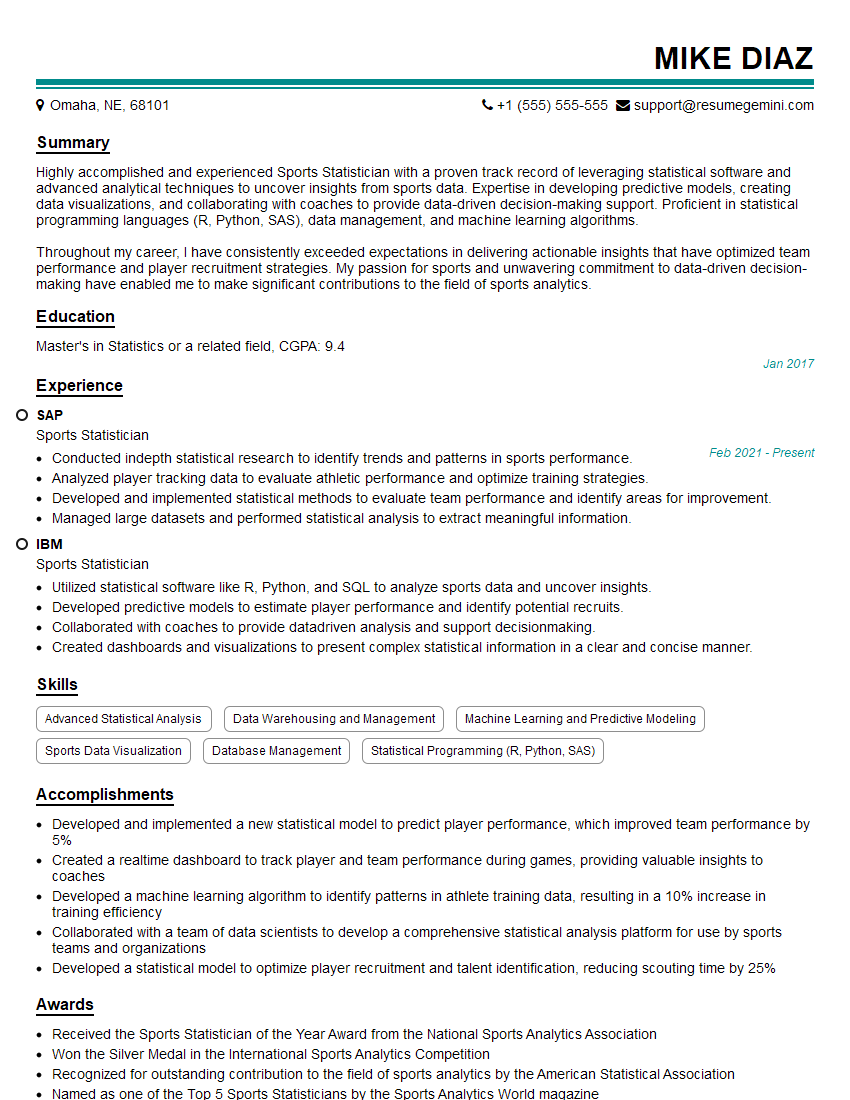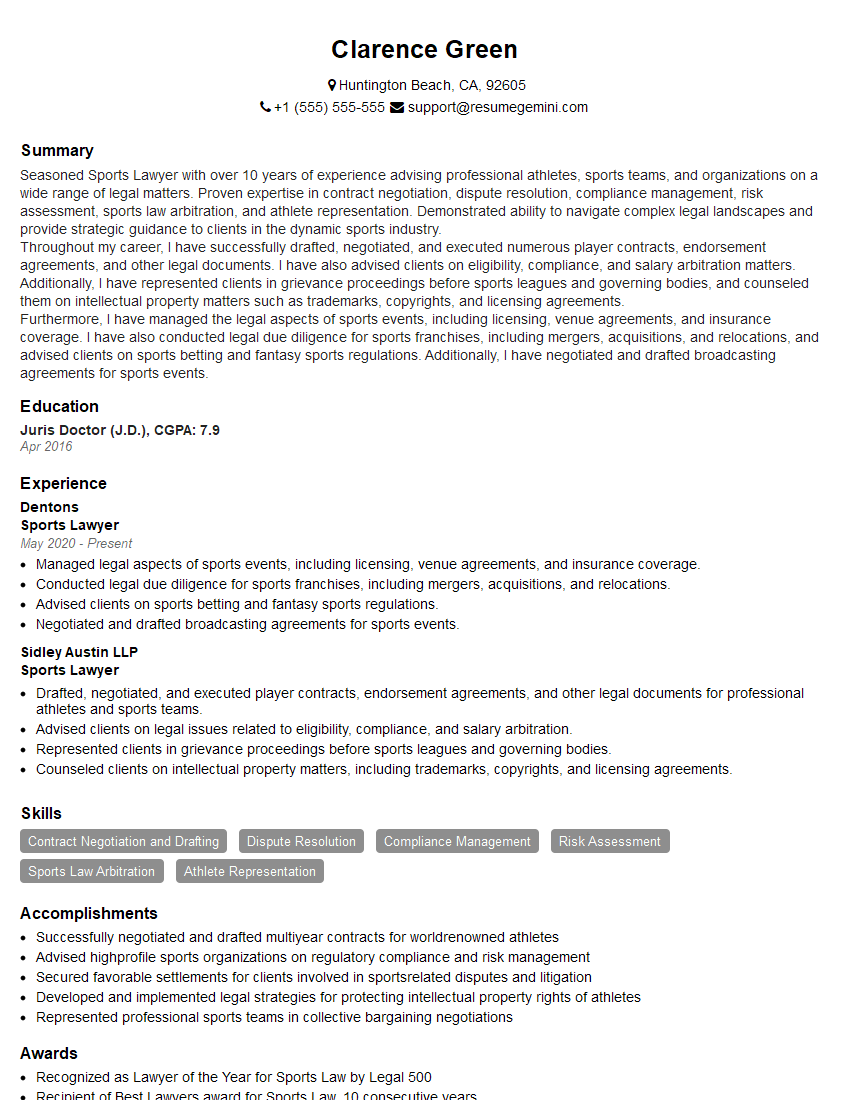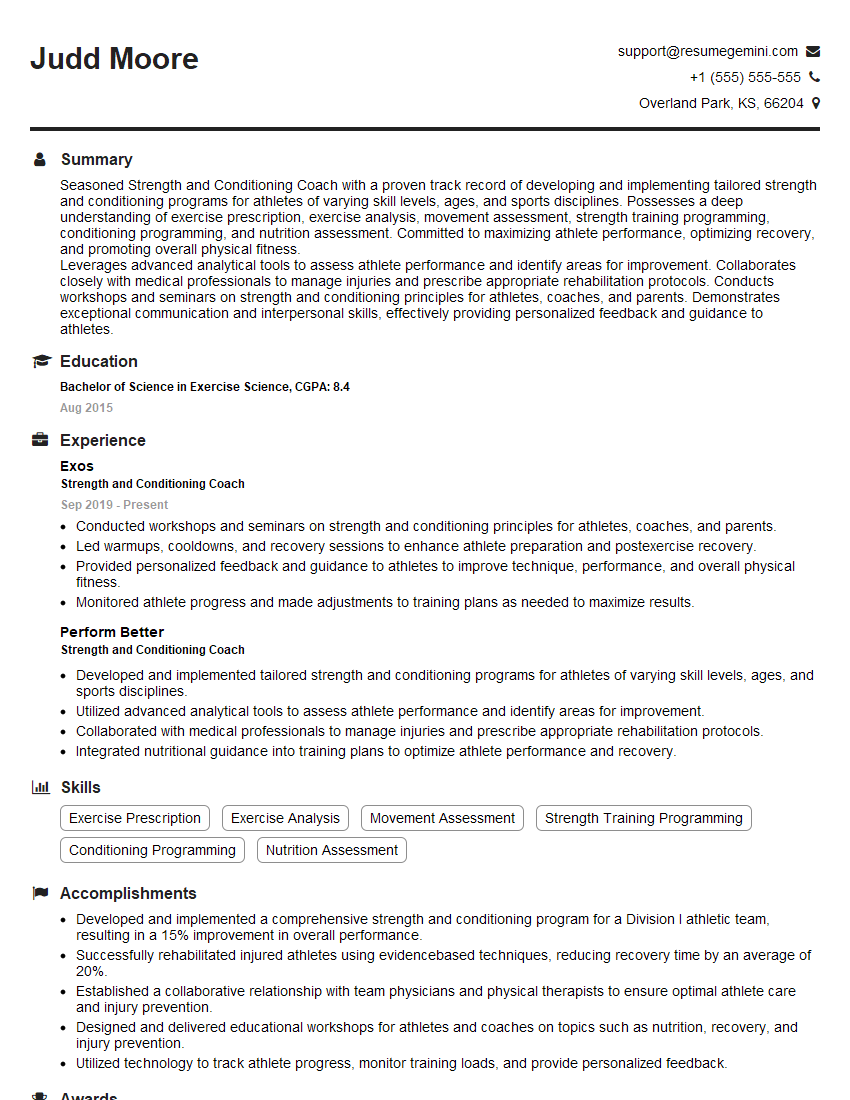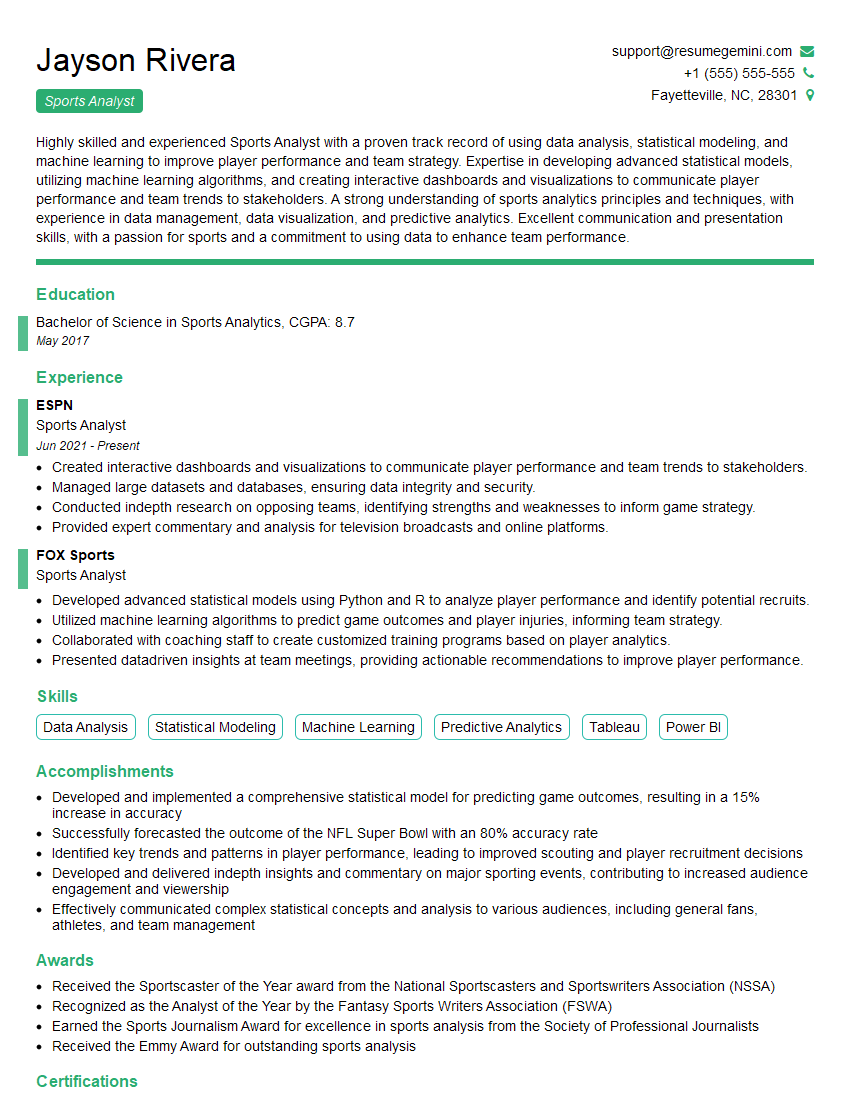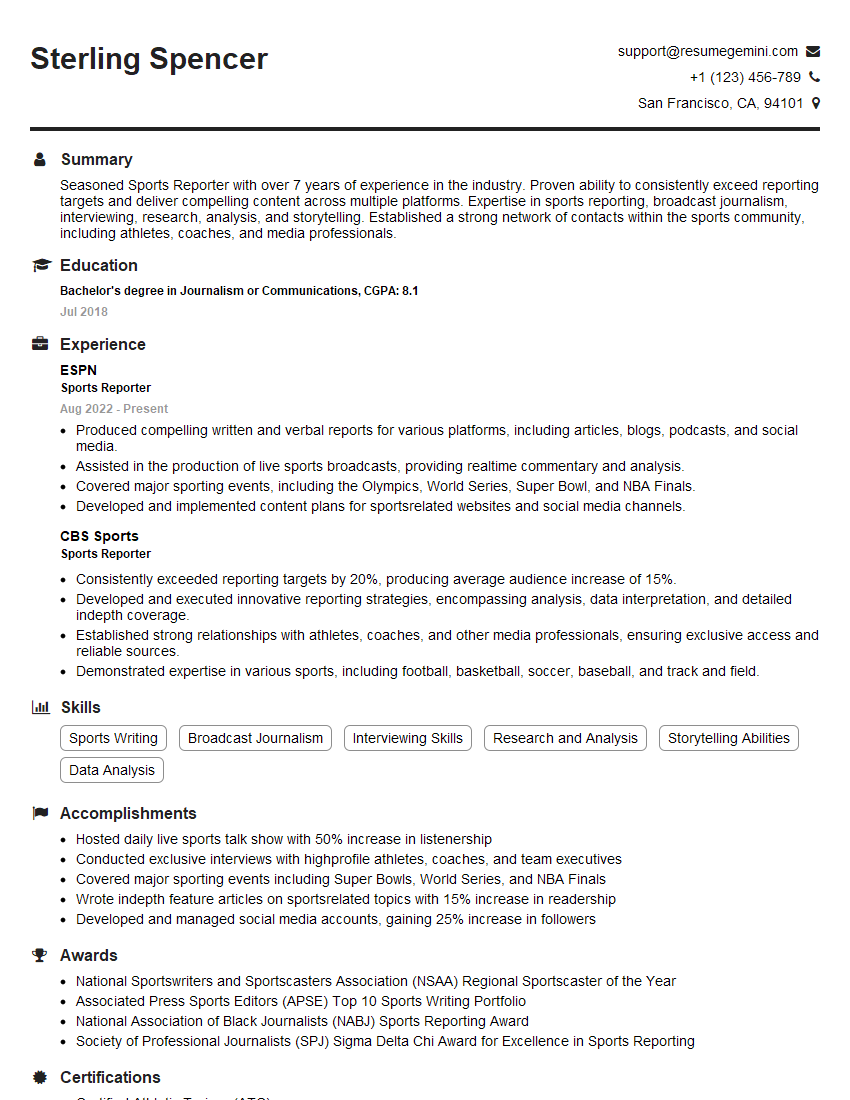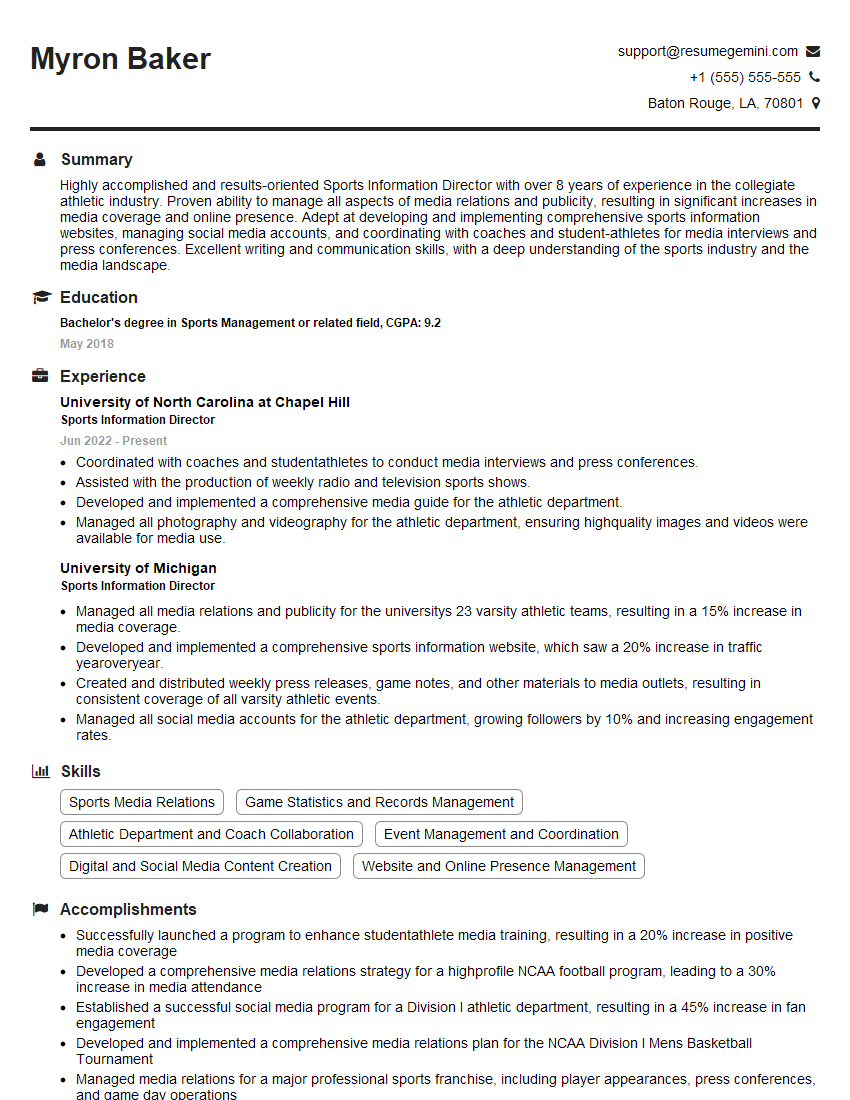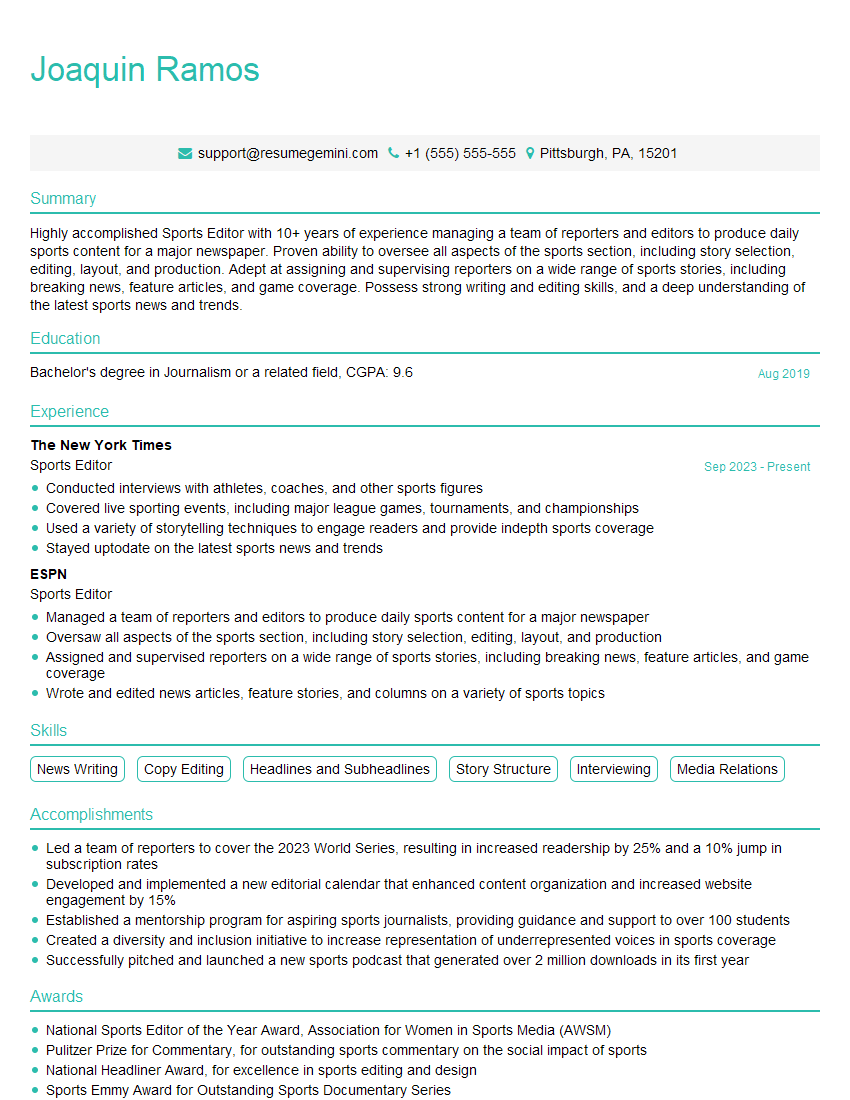The thought of an interview can be nerve-wracking, but the right preparation can make all the difference. Explore this comprehensive guide to Sports Terminology interview questions and gain the confidence you need to showcase your abilities and secure the role.
Questions Asked in Sports Terminology Interview
Q 1. Define ‘offside’ in soccer.
In soccer (football), being offside means a player is in an illegal position when a teammate plays the ball to them. It’s a crucial rule impacting gameplay.
Specifically, a player is offside if:
- They are in the opponent’s half of the field.
- They are closer to the opponent’s goal line than both the ball and the second-to-last defender (excluding the goalkeeper).
Think of it like this: imagine a race. If you start running before the starting gun, you’re ahead of the others. In soccer, being offside is like getting a head start by being too close to the goal before the ball is played.
Example: If a forward is positioned beyond the last defender when their teammate passes the ball, and the pass reaches them, the referee will likely call an offside. The goal would not count, and play restarts with a free kick for the opposing team.
Q 2. Explain the difference between a ‘strikeout’ and a ‘walk’ in baseball.
In baseball, a strikeout and a walk are two vastly different outcomes of a batter’s at-bat, reflecting different pitcher-batter dynamics.
A strikeout occurs when a batter fails to hit three pitches called strikes by the umpire. These strikes are called based on whether the umpire deems the pitch crosses the designated strike zone, typically defined as the area over home plate between the batter’s knees and armpits.
A walk (also called a base on balls), on the other hand, is awarded to a batter if the pitcher throws four pitches outside of the strike zone, which the batter doesn’t swing at. Even though the batter doesn’t swing, the umpire’s judgment determines whether the pitch is outside the strike zone. Four such balls (outside the strike zone, not swung at) constitute a walk, and the batter automatically advances to first base.
In essence: A strikeout indicates the pitcher’s dominance, while a walk often shows the pitcher’s lack of control or the batter’s patience and discipline.
Q 3. What is a ‘down’ in American football?
In American football, a ‘down’ represents one of four attempts a team has to advance the ball at least 10 yards. It’s a fundamental element that structures the game’s offensive strategy.
Each team’s possession begins with four downs. They can attempt to gain the 10 yards through running plays (handoffs to a running back), passing plays (quarterback throwing to a receiver), or a combination of both. If they succeed within those four downs, they retain possession, and the clock continues. If they don’t achieve the 10 yards within four downs, possession changes to the opposing team.
Example: If a team gains 7 yards on their first down, they still need 3 more yards on the remaining three downs. If they are unsuccessful, the opposing team takes possession from where they left off.
Q 4. Describe the concept of ‘a deuce’ in tennis.
In tennis, ‘deuce’ signifies a tied score of 40-40 in a game. It’s a critical point where the scoring system transitions from standard numbering to ‘advantage’ points.
Once a deuce is reached, players must win two consecutive points to win the game. If one player wins a point, the score becomes ‘advantage’ for that player. If they win the next point, they win the game. However, if the other player wins the point, the score returns to deuce.
Example: Let’s say Player A and Player B reach a score of 40-40 (deuce). If Player A wins the next point, the score is ‘advantage A’. If Player A wins again, they win the game. But if Player B wins that ‘advantage’ point, the score reverts to deuce, requiring more points to decide the game.
Q 5. What constitutes a ‘hole-in-one’ in golf?
In golf, a hole-in-one, also known as an ace, is achieved when a player hits the ball into the hole with a single stroke from the teeing ground. It’s a highly sought-after and celebrated feat.
This requires precision, power, and a bit of luck. The ball must not only travel the necessary distance but also accurately land in the hole without bouncing or rolling in.
Example: A golfer tees off on a par-3 hole (meaning it should take three strokes to complete) and directly sinks the ball into the cup in one shot—this is a hole-in-one.
Q 6. Explain the meaning of ‘triple crown’ in horse racing.
In horse racing, the Triple Crown refers to the achievement of winning three specific prestigious races in the same year: the Kentucky Derby, the Preakness Stakes, and the Belmont Stakes. It’s a rare and extraordinary accomplishment.
These races are run in the United States, and winning all three requires exceptional speed, stamina, and talent in a horse, as well as top-notch training and handling by the jockey and support team. The three races are held over a relatively short period, requiring consistent peak performance from the horse over several weeks.
Example: A horse that wins the Kentucky Derby, the Preakness Stakes, and the Belmont Stakes in the same year earns the coveted Triple Crown title.
Q 7. What is a ‘slam dunk’ in basketball?
In basketball, a slam dunk is a spectacular way to score where a player leaps high above the basket and forcefully throws the ball downward through the hoop. It’s known for its visual appeal and high degree of skill.
The player must jump, typically quite high, and forcefully slam the ball through the hoop from above the rim. It often involves a powerful jump and stylish maneuver before the dunk.
Example: A player dribbling towards the basket, powerfully jumps, and slams the ball through the hoop with both hands – this is a classic slam dunk.
Q 8. Define ‘penalty kill’ in hockey.
A penalty kill in hockey refers to the situation where a team plays shorthanded, meaning they have fewer players on the ice due to a penalty called against one of their players. The objective of the penalty kill is to prevent the opposing team, who now has a power play (more players on the ice), from scoring while they are shorthanded. Think of it as a defensive stand, akin to holding off an attack in a siege.
For example, if a player on Team A receives a two-minute penalty for tripping, Team A is now on a penalty kill for those two minutes. They will play with only four skaters (instead of five) and their goaltender against Team B’s five skaters and goaltender. Successful penalty kills often involve aggressive forechecking (intense pursuit of the puck to disrupt the attacking team) and diligent defensive positioning to limit shots on goal.
Q 9. Explain the difference between a ‘grand slam’ and a ‘home run’ in baseball.
Both a grand slam and a home run in baseball involve hitting a fair ball that allows the batter to circle all four bases and score a run, but a grand slam is a *specific type* of home run.
- Home run: A home run is simply any fair ball hit that allows the batter to score a run without being put out. This can happen with nobody on base, one runner on base, two runners on base, etc. Any hit clearing the fence is often a home run.
- Grand slam: A grand slam is a home run hit *with bases loaded* (meaning there is a runner on first, second, and third base). This results in four runs scored: one for the batter and one for each of the three base runners. It’s the ultimate home run situation.
In short, all grand slams are home runs, but not all home runs are grand slams. Imagine it this way: a home run is the general category, and a grand slam is a specific, high-value subcategory.
Q 10. What is a ‘no-hitter’ in baseball?
A no-hitter in baseball is a game where a pitcher (or pitchers, if more than one pitcher pitches throughout the game) prevents the opposing team from getting a single hit. It’s a remarkable feat of pitching dominance, showcasing incredible control, precision, and the ability to consistently outwit batters. Note that walks (when a batter reaches base without hitting a fair ball) and errors (defensive mistakes that allow a batter to reach base) are allowed to occur in a no-hitter, but no hits are recorded.
The pressure on the pitcher during a no-hitter is immense, as each batter presents a fresh opportunity to break the streak. Many no-hitters are ultimately broken late in the game, highlighting the rarity and impressive skill involved in achieving this milestone. A perfect game is a far rarer feat, which would include a no-hitter but with no walks or errors.
Q 11. What is ‘icing’ in hockey?
Icing in hockey occurs when a defending team shoots the puck from beyond their center red line and it crosses the opposing team’s goal line before any opposing player touches it. The referee will whistle and stop play immediately and a face-off will occur at the defensive team’s end of the ice. This is primarily a rule intended to prevent teams from repeatedly shooting the puck down the ice to simply stop play and give their players a rest. The team icing the puck will be penalized with a faceoff, but not a power play opportunity for the opposing team.
Think of it as a way to prevent stalling tactics or time wasting at the end of a game where one team may be trying to keep the puck out of their defensive zone.
Q 12. Explain the term ‘power play’ in hockey.
A power play in hockey is when a team has more players on the ice than the opposing team due to a penalty called on the opposing team. This typically means the penalized team plays shorthanded (with one fewer player) while the other team enjoys a numerical advantage. The power play provides a significant scoring opportunity, as the team with the advantage has more time and space to create scoring chances.
For instance, if a player on Team B receives a penalty for slashing, Team A is on a power play. They will have five skaters against Team B’s four skaters, allowing for greater control of the puck and more effective offensive maneuvers. Teams develop specific power-play strategies and formations designed to capitalize on this advantage.
Q 13. What is a ‘bye’ in a tournament bracket?
In a tournament bracket, a bye is a position that allows a team or player to advance to the next round without having to play a game in the current round. This is typically used in brackets with an uneven number of participants to ensure everyone has an equal number of opportunities to move forward. It is often assigned to a high seed.
For example, if a tournament has 7 teams, one team would receive a bye and proceed directly to the second round. The bye is usually assigned based on seeding or ranking, giving a higher-ranked team a strategic rest.
Q 14. What does ‘roughing the passer’ mean in American football?
Roughing the passer in American football is a penalty called against a defensive player who makes unnecessary or excessive contact with the quarterback after he has thrown or released the football. This is intended to protect the quarterback after the throwing motion is complete. The key element is the ‘unnecessary or excessive’ nature of the contact; a normal tackle or hit isn’t roughing the passer unless it goes beyond what’s considered acceptable within the rules.
The penalty typically results in yardage being assessed against the defensive team, giving the offensive team a better field position. The severity of the penalty can vary depending on the context of the hit, with particularly violent or dangerous actions resulting in more severe penalties or even ejection from the game.
Q 15. Explain ‘the zone’ in basketball.
In basketball, ‘the zone’ refers to a state of heightened performance where a player experiences an almost supernatural level of skill and focus. It’s a feeling of effortless execution, perfect shot selection, and unwavering confidence. Think of it as being completely in sync with the game, anticipating plays before they happen and making seemingly impossible shots.
While there’s no scientific explanation for ‘the zone,’ it’s often attributed to a combination of factors: peak physical and mental conditioning, intense concentration, and a flow state where actions become automatic and intuitive. Players often describe it as a feeling of time slowing down, allowing them to process information and react more quickly and effectively.
For example, legendary basketball player Michael Jordan was known for entering ‘the zone’ during crucial moments of games, seemingly scoring at will. This state of peak performance is highly sought after by athletes of all levels, and achieving it requires extensive training, mental discipline, and a deep understanding of the game.
Career Expert Tips:
- Ace those interviews! Prepare effectively by reviewing the Top 50 Most Common Interview Questions on ResumeGemini.
- Navigate your job search with confidence! Explore a wide range of Career Tips on ResumeGemini. Learn about common challenges and recommendations to overcome them.
- Craft the perfect resume! Master the Art of Resume Writing with ResumeGemini’s guide. Showcase your unique qualifications and achievements effectively.
- Don’t miss out on holiday savings! Build your dream resume with ResumeGemini’s ATS optimized templates.
Q 16. Define ‘forehand’ and ‘backhand’ in tennis.
In tennis, the terms ‘forehand’ and ‘backhand’ describe the way a player hits the ball. They are based on the player’s dominant hand and its position relative to the ball.
- Forehand: This is the stroke executed with the dominant hand on the same side of the body as the ball. Imagine you’re right-handed; if the ball is coming to your right, you’ll hit it with your right hand using a forehand stroke. It’s generally considered the more powerful and easier shot for most players.
- Backhand: This stroke is performed with the non-dominant hand on the opposite side of the body from the ball. Again, for a right-handed player, the ball arriving on the left would be played using their backhand. This shot often requires more technique and finesse than the forehand.
Understanding the difference is crucial to analyzing tennis matches. Players often have distinct strengths and weaknesses on either side, influencing their strategy and shot selection. A player with a powerful forehand might try to consistently move their opponent to that side, making it difficult for them to return.
Q 17. What is a ‘shortstop’ in baseball?
In baseball, the shortstop is an infielder who plays between second and third base. They are typically considered the most athletic infielder due to the wide range of plays they are responsible for handling. The shortstop’s position requires quick reflexes, strong throwing arm, exceptional agility, and the ability to cover a large area of the infield.
The shortstop is often the key player in turning double plays, working in conjunction with the second baseman to quickly and efficiently get two outs. Their positioning and reaction times are critical in preventing runners from advancing.
Think of them as the quarterback of the infield defense – orchestrating plays, positioning other fielders, and making crucial defensive plays.
Q 18. What is a ‘forward’ in soccer?
In soccer, a forward is an offensive player whose primary role is to score goals. Forwards are usually positioned closest to the opposing team’s goal and are responsible for creating scoring opportunities and finishing attacks. They are often characterized by their speed, agility, shooting accuracy, and ability to dribble the ball effectively under pressure.
Different types of forwards exist, each with specialized roles. Some forwards specialize in quick, direct runs to goal, while others focus on passing, creating space and assisting teammates. A team’s formation and strategy will often dictate the specific role of their forwards.
Consider a classic striker; they are usually positioned centrally and primarily focused on goal-scoring. Wingers, on the other hand, usually operate on the flanks and aim to cross the ball into the box for teammates.
Q 19. What does ‘love’ mean in tennis?
In tennis, ‘love’ means zero. It’s a unique term that’s been carried over from the game’s history and is used to describe a score of zero points in a game. So, if the score is ‘love-fifteen,’ it means one player has zero points and the other has fifteen.
The origin of the word ‘love’ in this context isn’t fully certain, but it’s believed to be derived from the French word ‘l’oeuf,’ meaning ‘egg,’ which is visually similar to the shape of zero.
Q 20. Explain ‘sudden death’ overtime.
Sudden death overtime is a method used to determine a winner in a tied game or match after regulation time has ended. The key feature is that the first team or player to score wins; there are no additional periods or rounds played unless there’s a tied score immediately after the OT period. The specific rules can vary by sport, but the fundamental principle remains the same: the first score decides the victor.
For example, in many ice hockey playoff games, if the teams are tied at the end of regulation time, a five-minute sudden death overtime is played. The first team to score a goal wins the game. If no team scores within those five minutes, the game may continue to further sudden death periods.
The high stakes and pressure involved during sudden death make it a particularly thrilling and dramatic part of many sporting events.
Q 21. What is the difference between a ‘foul’ and a ‘penalty’ in basketball?
In basketball, both fouls and penalties are infractions, but they have different implications.
- Foul: A foul is an illegal contact or action against an opponent. This could involve illegal contact, pushing, holding, or charging. Fouls result in free throws for the opposing team (depending on the location of the foul) and sometimes possession.
- Penalty: A penalty is a more serious infraction, often resulting in a harsher consequence. While some fouls can also be deemed as penalties, this usually occurs for actions deemed more egregious, or repeated fouls by the same player. Penalties might include technical fouls (resulting in free throws and/or possession), flagrant fouls (leading to ejection and suspension), or disqualifications.
The difference lies mainly in the severity and the consequences. A simple foul might be a push, while a flagrant foul might involve violent or unsportsmanlike conduct. Referees use their judgment to determine whether an infraction is a regular foul or a penalty.
Q 22. Define ‘sweep’ in American football.
In American football, a ‘sweep’ is a running play designed to attack the edge of the offensive line. It’s characterized by the offensive line blocking downfield, typically toward one side of the field, creating a path for the running back to run laterally and then towards the sideline. Think of it as a play that ‘sweeps’ across the field.
The effectiveness of a sweep relies on several factors: the offensive line’s ability to effectively block downfield (preventing defenders from reaching the running back), the running back’s agility and speed to follow the blocking, and the quarterback’s ability to accurately read the defense and make quick decisions about the play’s execution. A successful sweep often results in a significant gain of yards.
Example: Imagine the offensive line blocking towards the left side. The running back takes the handoff and initially runs left, following the blocks, before cutting upfield for a large gain. A successful sweep often leaves defenders scrambling to catch up.
Q 23. Explain ‘offside’ in basketball.
In basketball, ‘offside’ is a violation that occurs when a player enters the free-throw lane (also known as the ‘key’ or ‘painted area’) before the ball is legally released on a free throw. It’s like jumping the gun; the player must wait until the ball leaves the shooter’s hand.
The referee will call an ‘offside’ violation if a player encroaches into the restricted area before the free throw is attempted. The offended team gets possession of the ball.
Example: A player eagerly anticipating the rebound during a free throw starts moving into the lane before the ball is released. This would be considered offside, resulting in a violation. Good offensive rebounders know to time their entry into the key perfectly, avoiding this penalty.
Q 24. What is ‘the drop’ in rugby?
In rugby, ‘the drop’ refers to a type of place kick. The kicker drops the ball from their hands, allowing it to bounce once on the ground before they kick it. It’s a high-pressure shot often used for scoring points (conversion or penalty goal) or restarting play.
Unlike a drop goal in other sports, the drop in rugby union is a common way of kicking the ball for scoring or for play restart after a penalty. The kicker needs great precision and timing to execute the drop goal successfully.
Example: After scoring a try, the team is awarded a conversion. Their kicker might opt for a drop kick from relatively close range, giving them a good chance of scoring extra points.
Q 25. What is a ‘mugging’ in basketball?
In basketball, a ‘mugging’ is an illegal defensive foul where a defender uses excessive force to impede an offensive player’s progress. It is typically characterized by an overly aggressive physical play that restricts the offensive player’s movement, often with improper contact to the body, or excessive hand checking.
Mugging can involve a variety of actions, including excessively grabbing or holding a player’s jersey, using excessive force to push or shove a player, or wrapping around a player to restrict their movement. It is a more severe form of personal foul compared to simple fouls.
Example: A defender aggressively uses both hands to grab an offensive player’s jersey and prevent them from dribbling or shooting. This would likely be called a ‘mugging’ foul.
Q 26. Define ‘fairway’ in golf.
In golf, the ‘fairway’ is the closely mown area of grass between the teeing ground and the green on a golf hole. It’s the ideal area to hit your ball from, providing a relatively flat and clear surface for a good shot towards the green.
The fairway is usually significantly shorter than the rough (the area of longer, uncut grass surrounding the fairway) and provides more control and distance for the golfer. A ball landing in the fairway offers a much better chance of reaching the green with fewer strokes than one in the rough.
Example: A golfer’s drive lands neatly in the middle of the fairway. This puts them in a much more advantageous position compared to a drive landing in the rough or the woods.
Q 27. What is a ‘catch’ in cricket?
In cricket, a ‘catch’ is a method of dismissing a batsman by catching the ball after it has been hit by the bat, without the ball bouncing on the ground. The fielder must catch the ball cleanly and securely, holding onto it after a conclusive impact.
A catch must be taken cleanly. If the ball rebounds from the fielder’s hands before being securely held, it is not considered a valid catch. A catch is a crucial way to dismiss a batter and often leads to dramatic shifts in the game’s momentum.
Example: The batsman hits a hard-driven ball toward a fielder in the slips. The fielder catches the ball cleanly in one hand and immediately celebrates the wicket taken by catch.
Q 28. Explain ‘leg before wicket’ (LBW) in cricket.
In cricket, ‘leg before wicket’ (LBW) is a method of dismissing a batsman. It’s called when the ball would have hit the stumps (the three wooden sticks at the wicket) had it not been intercepted by the batsman’s leg.
Several conditions must be met for an LBW to be given out: The ball must be pitching in line with the stumps, hitting the leg in front of the stumps, and the ball would have gone on to hit the wickets.
Umpires make the LBW decision based on these factors, and it can be a highly debated call at times. Technology, such as ball-tracking systems, are frequently used to help review LBW decisions.
Example: A bowler bowls a ball that pitches in line with the stumps and strikes the batsman’s leg just in front of the stumps. The umpire judges that, had the leg not been in the way, the ball would have hit the stumps, and therefore gives the batsman ‘LBW’ out.
Key Topics to Learn for Sports Terminology Interview
- Common Sporting Terms & Jargon: Understanding the nuances of terminology across various sports (e.g., baseball, basketball, football, soccer). This includes understanding positions, rules, and common phrases used in commentary and analysis.
- Statistical Analysis in Sports: Familiarize yourself with key performance indicators (KPIs) and statistical measures used to evaluate player and team performance. Be prepared to discuss how these statistics inform strategic decisions.
- Sports Broadcasting & Commentary: Grasp the language and style used by sports commentators and analysts. Practice explaining complex sporting events and strategies concisely and engagingly.
- Sports Marketing & Branding: Understand how sports terminology is used in marketing campaigns and brand messaging. Be prepared to discuss the impact of language on fan engagement and brand perception.
- Sports Injury Terminology & Prevention: Depending on the specific role, you may need to understand common sports injuries, their terminology, and preventative measures. This could include understanding rehabilitation strategies.
- Legal Aspects of Sports: Depending on the role, knowledge of contract terminology, player rights, and relevant legal frameworks might be essential.
- Problem-Solving with Sports Data: Practice analyzing hypothetical scenarios using sports data. Be prepared to articulate your thought process and solutions clearly.
Next Steps
Mastering sports terminology is crucial for career advancement in numerous fields, including sports journalism, broadcasting, analytics, marketing, and management. A strong understanding of this specialized vocabulary demonstrates your expertise and passion, significantly increasing your chances of securing your dream role. To maximize your job prospects, it’s vital to craft a resume that effectively showcases your skills and experience to Applicant Tracking Systems (ATS). We highly recommend leveraging ResumeGemini to build a professional, ATS-friendly resume that highlights your knowledge of sports terminology. ResumeGemini provides examples of resumes tailored to sports terminology roles, helping you present your qualifications in the most impactful way. Take the next step in your career journey today!
Explore more articles
Users Rating of Our Blogs
Share Your Experience
We value your feedback! Please rate our content and share your thoughts (optional).
What Readers Say About Our Blog
Hello,
We found issues with your domain’s email setup that may be sending your messages to spam or blocking them completely. InboxShield Mini shows you how to fix it in minutes — no tech skills required.
Scan your domain now for details: https://inboxshield-mini.com/
— Adam @ InboxShield Mini
Reply STOP to unsubscribe
Hi, are you owner of interviewgemini.com? What if I told you I could help you find extra time in your schedule, reconnect with leads you didn’t even realize you missed, and bring in more “I want to work with you” conversations, without increasing your ad spend or hiring a full-time employee?
All with a flexible, budget-friendly service that could easily pay for itself. Sounds good?
Would it be nice to jump on a quick 10-minute call so I can show you exactly how we make this work?
Best,
Hapei
Marketing Director
Hey, I know you’re the owner of interviewgemini.com. I’ll be quick.
Fundraising for your business is tough and time-consuming. We make it easier by guaranteeing two private investor meetings each month, for six months. No demos, no pitch events – just direct introductions to active investors matched to your startup.
If youR17;re raising, this could help you build real momentum. Want me to send more info?
Hi, I represent an SEO company that specialises in getting you AI citations and higher rankings on Google. I’d like to offer you a 100% free SEO audit for your website. Would you be interested?
Hi, I represent an SEO company that specialises in getting you AI citations and higher rankings on Google. I’d like to offer you a 100% free SEO audit for your website. Would you be interested?
good


